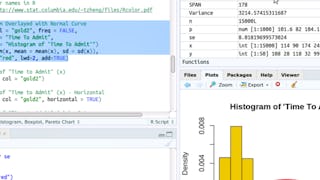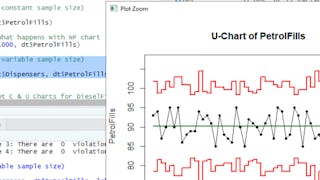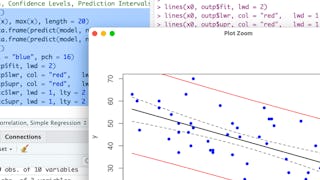Welcome to RStudio for Six Sigma - Process Capability. This is a project-based course which should take under 2 hours to finish. Before diving into the project, please take a look at the course objectives and structure.


Recommended experience
What you'll learn
Import datasets into RStudio; perform Process Capability Analysis
Use RStudio to calculate DPU, DPO, DPMO, Yield, Rolled Throughput Yield (RTY)
Use RStudio to calculate Short & Long Term Z Scores, Cp, Cpk, Pp and Ppk
Skills you'll practice
Details to know

Add to your LinkedIn profile
Only available on desktop
See how employees at top companies are mastering in-demand skills

Learn, practice, and apply job-ready skills in less than 2 hours
- Receive training from industry experts
- Gain hands-on experience solving real-world job tasks
- Build confidence using the latest tools and technologies

About this Guided Project
Learn step-by-step
In a video that plays in a split-screen with your work area, your instructor will walk you through these steps:
Introduction to RStudio environment; import data into RStudio and perform Process Capability Analysis.
Process Capability for Discrete Type I Data based on Product Quality - Individual and Overall DPU, DPO, DPMO and Z-Score.
Process Capability for Discrete Type II Data based on Product Quality - Individual and Overall DPU, Yield and Z-Score.
Process Capability based on Process Steps - Classical Yield, First Pass Yield and Rolled Throughput Yield (RTY) for Type I and II Discrete Data.
Process Capability for Continous Data - Calculating Z Score and DPMO for a Mean, Standard Deviation and Specification Limits.
Process Capability for Continous Data - Calculating Z Short Term (Potential), Z Long Term (Actual), Cp, Cpk, Pp, Ppk.
Recommended experience
Basic Statistics (RStudio for Six Sigma - Basic Descriptive Statistics), High School Math.
7 project images
Instructor

Offered by
How you'll learn
Skill-based, hands-on learning
Practice new skills by completing job-related tasks.
Expert guidance
Follow along with pre-recorded videos from experts using a unique side-by-side interface.
No downloads or installation required
Access the tools and resources you need in a pre-configured cloud workspace.
Available only on desktop
This Guided Project is designed for laptops or desktop computers with a reliable Internet connection, not mobile devices.
Why people choose Coursera for their career




You might also like
 Status: Free Trial
Status: Free Trial

Open new doors with Coursera Plus
Unlimited access to 10,000+ world-class courses, hands-on projects, and job-ready certificate programs - all included in your subscription
Advance your career with an online degree
Earn a degree from world-class universities - 100% online
Join over 3,400 global companies that choose Coursera for Business
Upskill your employees to excel in the digital economy
Frequently asked questions
By purchasing a Guided Project, you'll get everything you need to complete the Guided Project including access to a cloud desktop workspace through your web browser that contains the files and software you need to get started, plus step-by-step video instruction from a subject matter expert.
Because your workspace contains a cloud desktop that is sized for a laptop or desktop computer, Guided Projects are not available on your mobile device.
Guided Project instructors are subject matter experts who have experience in the skill, tool or domain of their project and are passionate about sharing their knowledge to impact millions of learners around the world.




